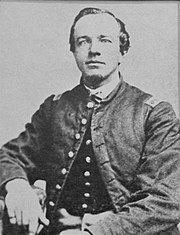
William H. Reddick
William Henry Harrison Reddick (1840-1903) was an American Civil War Medal of Honor recipient.[1] He received the Medal of Honor for his actions during the Andrews Raid, also known as the Great Locomotive Chase or the Mitchell Raid.[2] Reddick was born on September 18, 1840 in Locust Grove, Ohio, and died on November 8, 1903 in Muscatine, Iowa. He is buried at the Lettsville Cemetery in Letts, Iowa.[3] He worked as a farmer after his discharge from the military.[4]
Military Service[]
William H. Reddick enlisted with the 33rd Ohio Infantry on August 18, 1861.[5] In the spring of 1862, he volunteered to join a group selected from three Ohio regiments by James J. Andrews. Their mission was to steal a train in Georgia and destroy railway facilities. The operation ultimately was unsuccessful, and Reddick was imprisoned in Atlanta, along with thirteen of the other raiders (Andrews and seven others were executed.)[6] He attempted to escape in October 1862, but was recaptured and sent to Castle Thunder Prison in Richmond, Virginia in December, 1862. After a prisoner exchange in March, 1863, he traveled to Washington, DC where he and five of his fellow raiders received the Medal of Honor.[2] They were the first recipients of the medal.[7]
Medal of Honor Citation[]
Reddick was awarded the Medal of Honor on March 25, 1863 for his actions in April 1862. He was the sixth individual to receive the medal. The citation reads:
The President of the United States of America, in the name of Congress, takes pleasure in presenting the Medal of Honor to Corporal William Henry Harrison Reddick, United States Army, for extraordinary heroism on April, 1862, while serving with Company G, 21st Ohio Infantry, in action during the Andrew's Raid in Georgia. Corporal Reddick was one of the 19 of 22 men (including two civilians) who, by direction of General Mitchell (or Buell), penetrated nearly 200 miles south into enemy territory and captured a railroad train at Big Shanty, Georgia, in an attempt to destroy the bridges and tracks between Chattanooga and Atlanta.
References[]
- ↑ "William Reddick - Recipient -" (in en). http://valor.militarytimes.com/hero/3313.
- ↑ 2.0 2.1 "Louisa County IAGenWeb, Family Story". http://iagenweb.org/louisa/familystories/famreddicky.htm.
- ↑ "William Henry Harrision Reddick (1840-1903) -..." (in en). https://www.findagrave.com/memorial/18224/william-henry_harrision-reddick.
- ↑ United States Census, 1880." National Archives and Records Administration.
- ↑ Official Roster of the Soldiers of the State of Ohio. Deeds of Valor: How our Soldier-heroes won the Medal of Honor. Medal of Honor Recipients 1863-1994.
- ↑ "Andrews Raid" (in en). https://www.georgiaencyclopedia.org/articles/history-archaeology/andrews-raid.
- ↑ "CMOHS.org - History of the Medal of Honor". http://www.cmohs.org/medal-history.php.
The original article can be found at William H. Reddick and the edit history here.